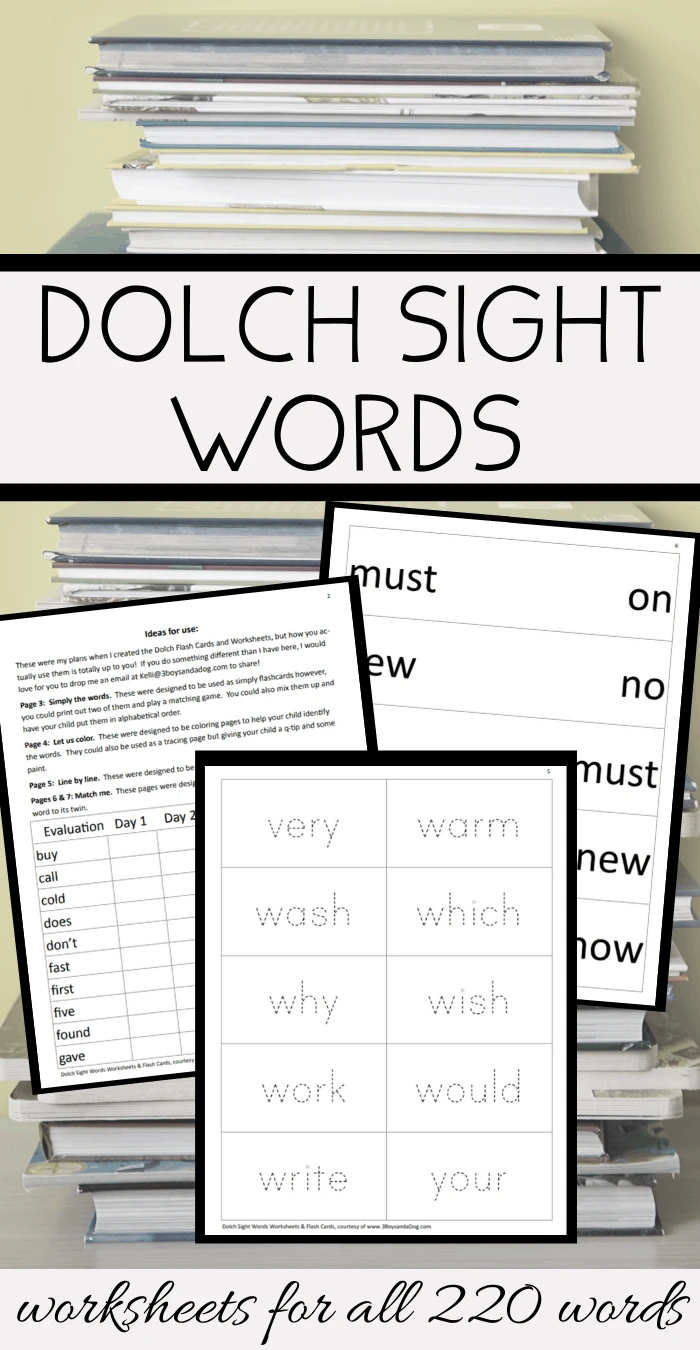Sight words are words that children should know just by looking at them. Learning the Complete List of Dolch Sight Words is one of the first steps to becoming a great reader.
Each set of words below is built to be done in a week as each pack has one worksheet per day. At the end of the 22 weeks, you can test your child with the flashcards and only work on the words they weren’t able to grasp.

Sight Words Worksheets
Each week contains enough worksheets to work on the 10 words for one week. The booklets also include all of the following:
- Flash Cards
- Handwriting Practice
- Coloring Page
- Matching
- Instructions for use
Each of the following links will bring up a new blog post. You can click the large image to download your pdf workbook inside each post.
Words 1-10 – a, and, away, big, can, come, down, find, for, funny
Words 11-20 – go, help, here, I, in, is, it, jump, little, look
Words 21-30 – make, me, my, not, one, play, run, said, see, the
Words 31-40 – blue, red, three, to, two, up we, where, yellow, you
Words 41-50 – all, am, are, at, ate, be, black, brown, but, came
Words 51-60 – did, do, eat, for, get, good, have, he, into, like
Words 61-70 – must, new, no, now, on, our, out, please, pretty, ran
Words 71-80 – ride, saw, say, she, so, soon, that, there, they, this
Words 81-90 – too, under, want, was, well, went, what, white, who, will
Words 91-100 – with, yes, after, again, an, any, as, ask, by, could
Words 101 – 110 – every, fly, from, give, giving, had, has, her, him, his
Words 111 – 120 – how, just, know, let, live, may, of, old, once, open
Words 121 – 130 – over, put, round, some, stop, take, thank, them, then, think
Words 131 – 140 – walk, were, when, always, around, because, been, before, best, both
Words 141 – 150 – buy, call, cold, does, don’t, fast, first, five, found, gave
Words 151 – 160 – goes, green, its, made, many, off, or, pull, read, right
Words 161 – 170 – sing, sit, sleep, tell, their, these, those, upon, us, use
Words 171 – 180 – very, warm, wash, which, why, wish, work, would, write, your
Words 181 – 190 – about, better, bring, carry, clean, cut, done, draw, drink, eight
Words 191 – 200 – fall, far, full, got, grow, hold, hot, hurt, if, keep
Words 201 – 210 – kind, laugh, light, long, much, myself, never, only, own, pick
Words 211 – 220 – seven, shall, show, six, small, start, ten, today, together, try
Dolch Sight Word Games & Books:
Here are a few of my top picks to help you reinforce the sight words to your kids!
- Meet the Sight Words Easy Reader Books (set of 12 books)nofollow
- Zingo Sight Wordsnofollow
- Sight Words Games & Flash Cards vol 1: Kids Learn to Readnofollow
What is a Dolch sight word?
Dolch sight words are a vital element of literacy. Encompassing frequently used nouns, verbs, adjectives, and adverbs, these 220 words make up between 50–75% of everyday writing materials.
Despite the common notion that they are solely pertinent to developing readers, many struggling adult readers also benefit from learning sight word recognition.
Dolch sight words have been broken down into a set of developmental lists determined by the student’s grade level, ranging from Pre-K all through to 3rd grade. Mastering this concept drastically improves a reader’s fluency and can bolster a student’s confidence in their reading abilities.
To assist with gaining this mastery, many efficient techniques, such as memorization through flashcards as well as tracking progress through incentives, can be employed in homes and classrooms alike.
Why are Dolch sight words important?
Dolch sight words, also known as high-frequency words, are essential for early literacy development. Research shows that the more children recognize and understand these critical words, the more quickly they learn to read.
Mastering sight words improve fluency by helping readers recognize phrases within a sentence instantly and accurately.
Knowing Dolch sight words provides a foundation for reading complex texts confidently and recognizing how to use context clues in unfamiliar word meanings.
In the debate of sight words vs phonics, it’s worth noting that while phonics skills are necessary for decoding unfamiliar words, sight words are critical for building reading fluency and comprehension. Without the ability to recognize sight words, reading can become slow and laborious, compromising overall reading comprehension.
Therefore, it is clear that teaching Dolch sight words is an indispensable part of developing strong early literacy skills.
How many Dolch sight words are there?
Dolch sight words, also known as Dolch Primer Sight Vocabulary, are a list of 220 words compiled by Dr. Edward William Dolch in 1948 that are commonly used in reading and writing.
The words on the list cannot easily be sounded phonetically but must be learned by sight.
This makes them essential for students beginning to learn how to read English. It is believed that mastering these sight words can account for up to 50% of all text encountered in school materials from kindergarten through third grade.
Research shows that familiarizing students with Dolch sight words early on can promote higher academic achievement during their primary education.
How can I introduce children to new Dolch sight words?
Introducing children to new Dolch sight words can be done in various ways. For younger students, it may be helpful to start by associating word cards with corresponding image cards so that the words become more familiar.
Another activity could be to allow children to build sentences with the sight words as they become more comfortable reading them or provide a checklist for each student to track which sight words they know.
Older students may require more advanced activities, such as word hunts, where they look for sight words in text and highlight or circle them when found.
Additionally, having children play games such as Boggle or Words With Friends using the Dolch sight words can further reinforce learning them. Through these activities, children will develop an understanding of and confidence with the new Dolch sight words quickly and effectively.
What strategies can I use to help my children remember the sight words?
Sight words are an essential part of a child’s literacy development, as they help to build the foundation for reading and writing. There are many strategies parents can use to help children remember sight words, such as providing visual cues, playing memory games, and discussing what the sight word means.
Visual cues are effective when teaching sight words because they enable children to connect the look of the word with its meaning.
Playing memory games helps to reinforce the notion that there is only one expression of a single word which preserves accuracy in spelling and pronunciation.
Furthermore, discussing a word’s meaning further engages a child with its visual representation and encourages them to interact with language more holistically.
Used together or individually, these strategies can be incredibly helpful in aiding children in committing sight words to memory.
What stories or books use Dolch sight words?
Many stories and books for young readers employ Dolch sight words to help children develop their reading skills. These books usually focus on themes that appeal to children and use repetition and other language techniques geared toward early readers.
Stories such as “The Cat in the Hat” by Dr. Seuss or “Hop On Pop” make extensive use of these words, allowing younger readers to engage more confidently with the text while building their vocabulary.
Similarly, classic works by renowned authors such as Robert Munsch’s “Love You Forever” also utilize Dolch sight words to help read with fluency, accuracy, and understanding.
As such, it is evident that using stories that employ the use of Dolch sight words can play a significant role in a child’s development as a reader.
How will memorizing the dolce site word help my child with future reading goals?
Memorizing the Dolch sight words is an effective way to help young readers prepare for future reading goals. Knowing these words and their common usage provides a basis for children to build on as their reading development progresses.
By learning these commonly used words, students can become more efficient readers and comprehend text faster.
In addition, many of these sight words are also used in oral and written language, helping children learn to communicate more effectively.
Through diligent practice and familiarity with the Dolch sight word list, children can establish essential building blocks necessary for successful reading experiences in the future.

